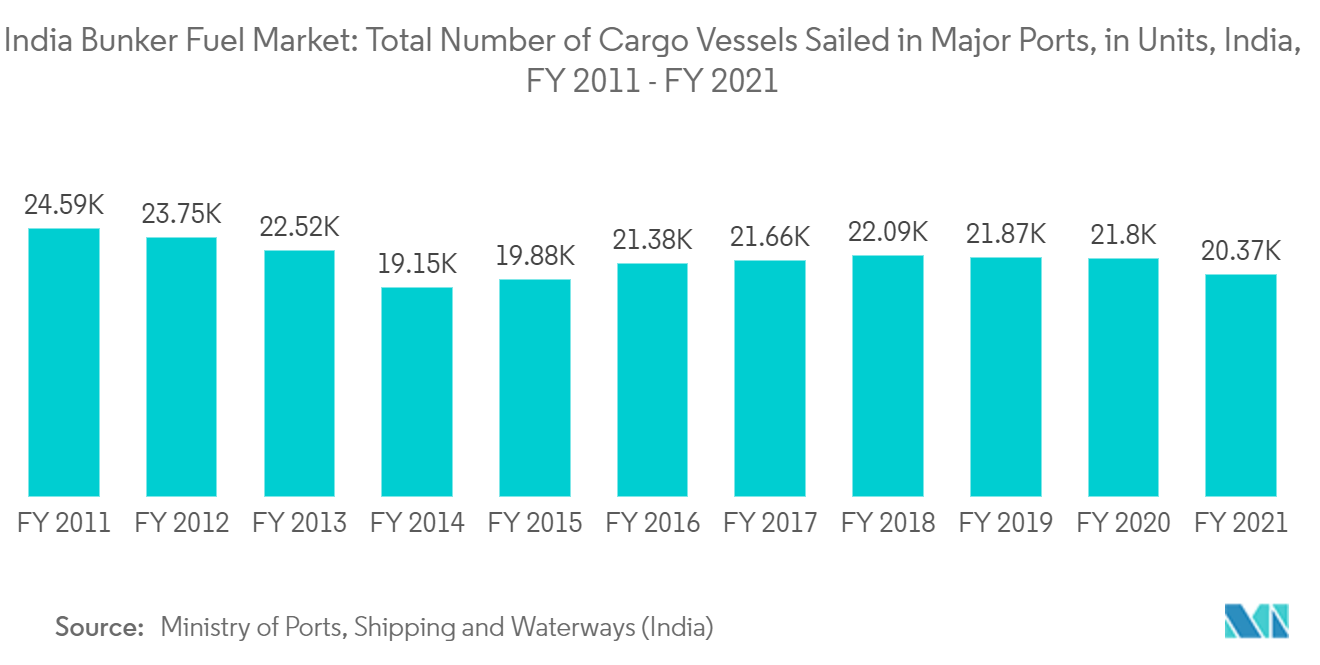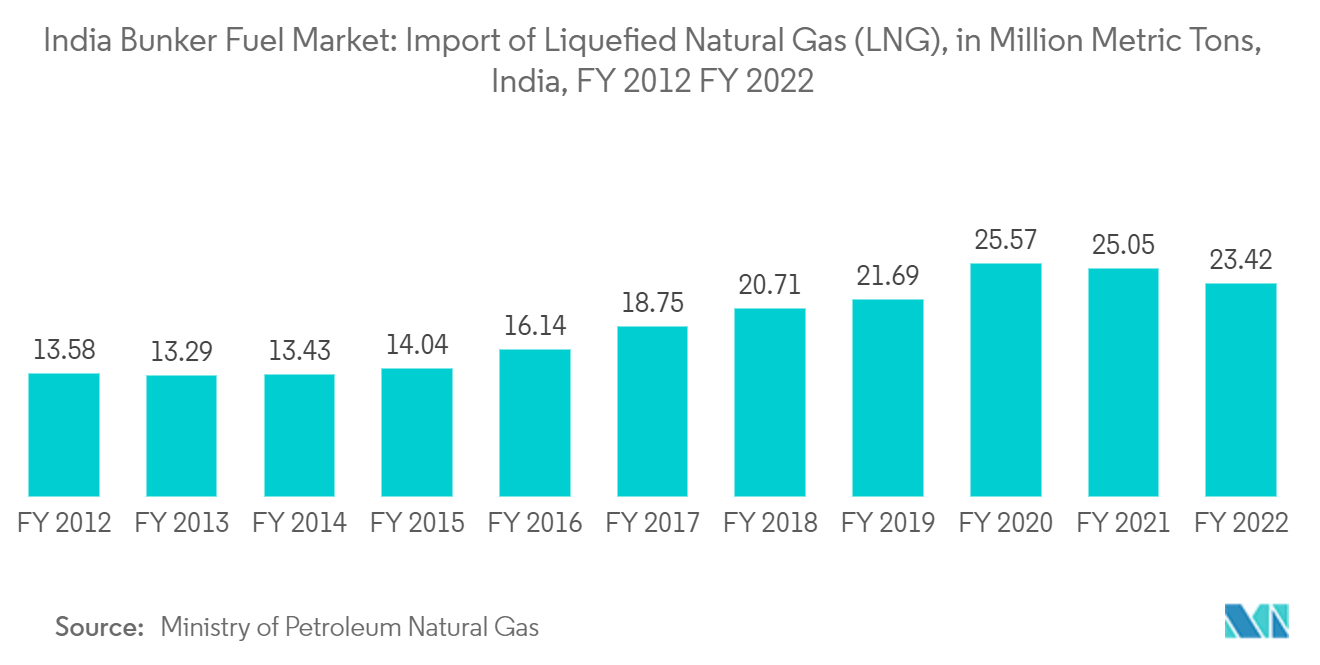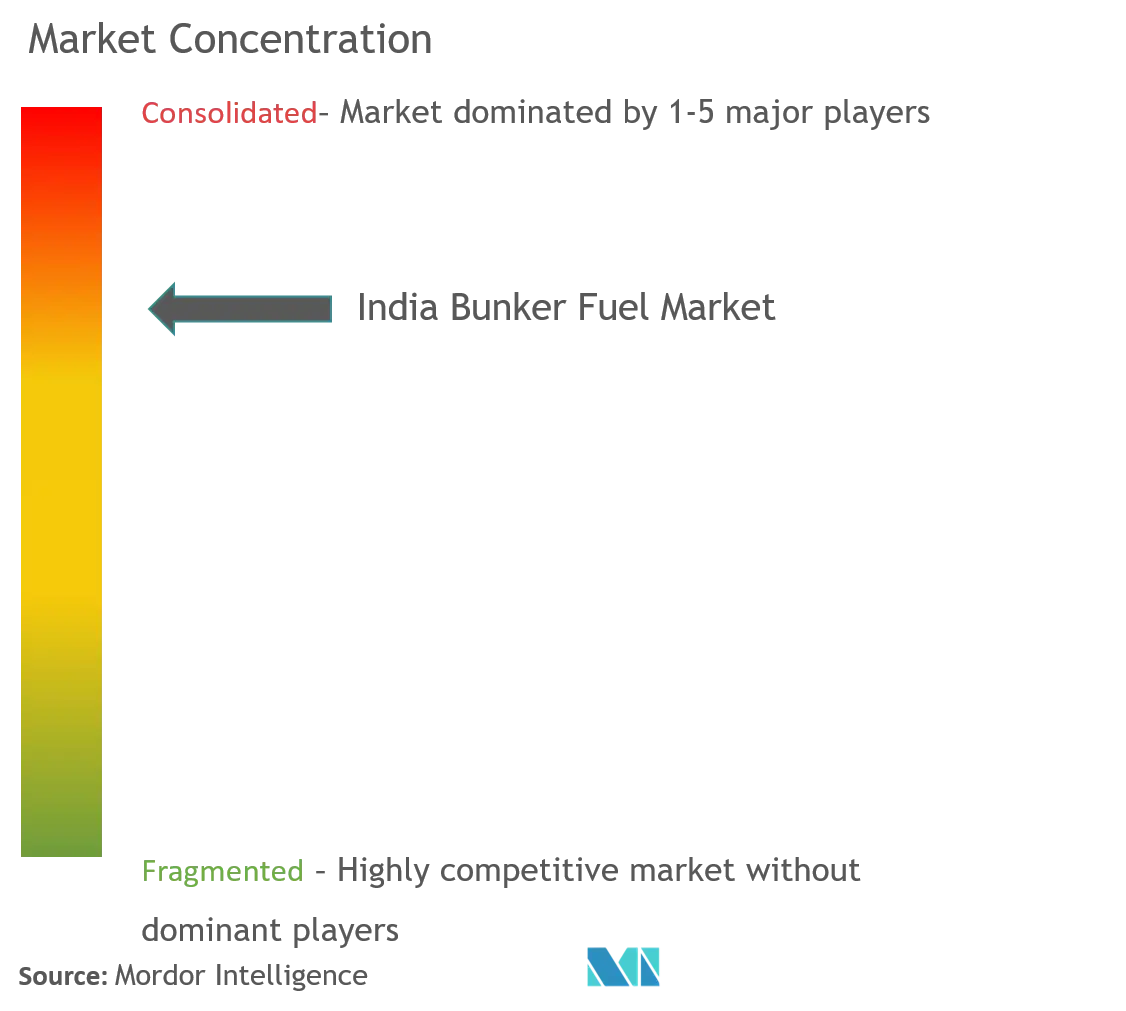India Bunker Fuel Market Analysis
The India Bunker Fuel Market is expected to register a CAGR of greater than 4% during the forecast period.
- Over the medium term, with a significant increase in LNG trade and upcoming LNG terminals, it is expected to have a growth in LNG carrier traffic in Indian ports, which is expected to have a positive effect on the market's growth during the forecast period.
- On the other hand, fluctuations in crude oil prices and bunker fuel prices are likely to slow market growth.
- Nevertheless, India is a net importer of goods. With the growing demand in trading activities, the port infrastructures are likely to get modernized and enlarged to increase their capacity. As part of the Sagarmala Programme, more than 574 projects were identified for modernization, port connectivity enhancement, and coastal community development during 2015-2035. Around 137 projects are under development in 2019 and are expected to be completed by 2035. Thus, such steps are likely to increase traffic at ports and thus create an opportunity for the market to grow in the near future.
India Bunker Fuel Market Trends
Very Low Sulfur Fuel Oil (VLSFO) to Witness Significant Growth
- Bunker fuels are rich in sulfur content and can emit toxic gases. However, the sulfur content can be reduced using different processes. One such type of fuel product is very low-sulfur fuel oil. VLSFO has sulfur contents of less than 0.5%, and the demand for this fuel is increasing after the imposition of IMO regulation in January 2020.
- As a way to reduce greenhouse gas emissions, the IMO regulation encourages ships to use low-sulfur fuel.This rule also encourages the use of fuels with less sulfur, which means that more of these fuels will be made.
- Due to the International Maritime Organization (IMO) 2020 regulation, it is expected that the demand for VLSFO will rise over the next few years.The increasing environmental concerns among the population in the country are another growth-driving factor for VLSFO.
- The country is taking several steps to comply with IMO regulations and promote the utilization of VLSFO. For instance, in 2020, the Government of India abolished the import tax on the VLSFO utilized by the ships.
- Some of the major ports in the country by marine traffic are Deendayal Port, Paradip Port, J. L. Nehru Port, Visakhapatnam Port, Mumbai Port, Chennai Port, and a few others. During FY 2021, the ports handled nearly 1251.28 million metric tons of goods, around 1320.0 in FY 2020. According to the Ministry of Ports, Shipping, and Waterways (India), a total of approximately 20 thousand vessels sailed from India's major ports during the fiscal year 2021.
- All of these things are expected to help the VLSFO segment grow over the next few years.
Rising Maritime Trade and LNG Terminal to Augment Growth
- During the time period predicted, the bunker fuel market in India is likely to grow a lot. During the forecast period, the country's bunker fuel market is expected to grow because of things like rising international trade and higher demand for different goods and fuels, like LNG.
- Furthermore, maritime is a suitable route for international trade as it is a convenient trade route, giving rise to maritime transport in India. The country is a net importer of things like LNG, crude oil, and others, and shipping is used to bring these things in.
- India imported about 23.6 million metric tons of LNG in FY 2022, according to the Ministry of Petroleum and Natural Gas.During the forecast period, it is expected to grow a lot because natural gas is being used more in many industries, such as city gas distribution (CGD), power, fertilizer, and refining.
- India is also a big importer of natural gas, which makes the need for natural gas trade even higher. Furthermore, it increases the demand for the natural gas terminal. With the increasing demand for natural gas, the government plans to build four more terminals in the country. Thus, an increasing number of such terminals is expected to increase the import capacity of LNG to around 50 MMTPA by 2025.
- In January 2022, LNG Alliance proposed to the Government of Karnataka and NMPT that a large LNG import terminal be built in Karnataka. The terminal would have an initial capacity of 4 million tons per annum (MTPA) and could grow to 8 MTPA as demand grows over the next twenty years.This import and regasification terminal will have places for ISO LNG containerization and LNG truck loading, which will help the industry and transportation sectors.It will also be India's first LNG bunkering facility. Ships visiting the NMPT port will be able to get LNG fuel and bunker shuttles to the West Coast of India from this facility.
- So, the above situation is likely to help India's trade business and is expected to drive the marine fuel market over the next few years.
India Bunker Fuel Industry Overview
The Indian bunker fuel market is moderately consolidated. Some of the major bunker fuel suppliers in the market (in no particular order) include Indian Oil Corporation Ltd., Hindustan Petroleum Corporation Ltd., Bharat Petroleum Corporation Ltd., Mangalore Refinery and Petrochemicals Ltd. (MRPL), and Adani Bunkering Private Limited, among others.
India Bunker Fuel Market Leaders
-
Indian Oil Corporation Ltd
-
Hindustan Petroleum Corporation Ltd
-
Bharat Petroleum Corporation Ltd
-
Adani Bunkering Private Limited
-
Mangalore Refinery and Petrochemicals Ltd (MRPL)
- *Disclaimer: Major Players sorted in no particular order
India Bunker Fuel Market News
- December 2022: Atlantic Gulf & Pacific International Holdings (AG&P) and Abu Dhabi National Oil Company (ADNOC) signed an agreement to use its Ghasha liquefied natural gas (LNG) carrier as a floating storage unit offshore India. The carrier will be used at AG&P's LNG import terminal in India, which is expected to open in the second half of 2024, according to ADNOC Logistics and Services.The agreement is valid for 11 years and could be extended for four years.
- January 2022: LNG Alliance signed a cooperation agreement with the New Mangalore Port Trust for the development of an LNG port terminal with an initial capacity of 4 million tons, which can be expanded to 8 million tons yearly. This terminal will be India's first LNG bunkering facility, providing LNG bunkering for ships.
India Bunker Fuel Industry Segmentation
Bunker fuel is the general term given to any fuel poured into a ship's bunkers to power its engines. Most deep-sea cargo ships burn the heavy oil that is left over from refining crude oil after gasoline, diesel, and other light hydrocarbons are taken out.
The Indian bunker fuel market is segmented by fuel type and vessel type. By fuel type, the market is segmented into high-sulfur fuel oil (HSFO), very low-sulfur fuel oil (VLSFO), marine gas oil (MGO), liquefied natural gas (LNG), and others. By vessel type, the market is segmented into containers, tankers, general cargo, bulk containers, and others. For each segment, market sizing and forecasts have been done based on revenue (USD million).
| Fuel Type | High Sulfur Fuel Oil (HSFO) |
| Very-low Sulfur Fuel Oil (VLSFO) | |
| Marine Gas Oil (MGO) | |
| Other Fuel Types | |
| Vessel Type | Containers |
| Tankers | |
| General Cargo | |
| Bulk Carrier | |
| Other Vessel Types |
India Bunker Fuel Market Research FAQs
What is the current India Bunker Fuel Market size?
The India Bunker Fuel Market is projected to register a CAGR of greater than 4% during the forecast period (2025-2030)
Who are the key players in India Bunker Fuel Market?
Indian Oil Corporation Ltd, Hindustan Petroleum Corporation Ltd, Bharat Petroleum Corporation Ltd, Adani Bunkering Private Limited and Mangalore Refinery and Petrochemicals Ltd (MRPL) are the major companies operating in the India Bunker Fuel Market.
What years does this India Bunker Fuel Market cover?
The report covers the India Bunker Fuel Market historical market size for years: 2019, 2020, 2021, 2022, 2023 and 2024. The report also forecasts the India Bunker Fuel Market size for years: 2025, 2026, 2027, 2028, 2029 and 2030.
Our Best Selling Reports
India Bunker Fuel Industry Report
Statistics for the 2025 India Bunker Fuel market share, size and revenue growth rate, created by Mordor Intelligence™ Industry Reports. India Bunker Fuel analysis includes a market forecast outlook for 2025 to 2030 and historical overview. Get a sample of this industry analysis as a free report PDF download.

.webp)





